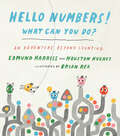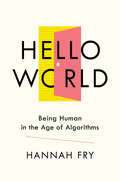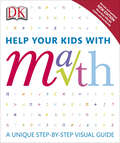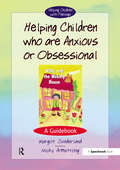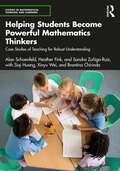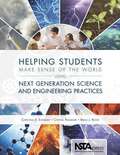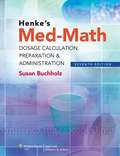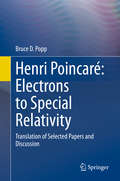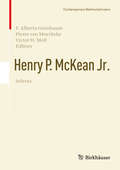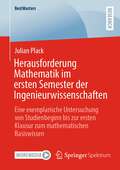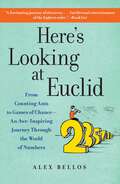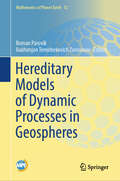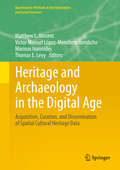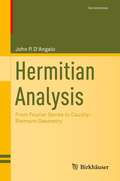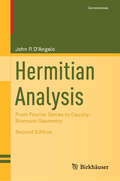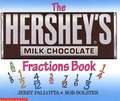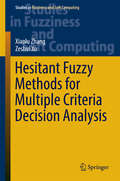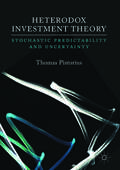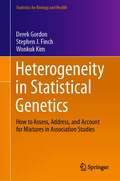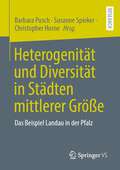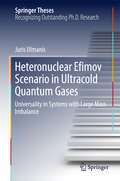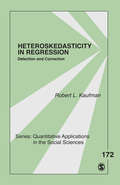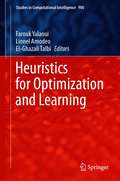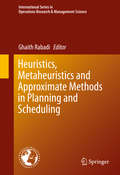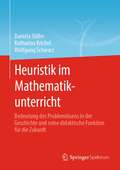- Table View
- List View
Hello Numbers! What Can You Do?: An Adventure Beyond Counting
by Edmund Harriss Houston HughesLearning meets wonder when you invite numbers to come play in your imagination! <P><P> First think of One peeking out from the night Like a point, or a dot, or a shimmering light. But when One finds a friend to run from or run to, Then we can’t call both “One”—that new One must be Two! And should you want something to go in between, You’ll need a new number, a number like Three. Four makes a square when it’s standing around, But what would you see if it flies off the ground? And then when another new One comes to mind, Yell out its name if you know it . . . it’s Five! Do you like the way that these numbers are sounding? Then join our adventure to count beyond counting! Hello Numbers! What Can You Do? is not like any other counting book. As each “new One” appears on the scene, the numbers’ antics hint at ever-deeper math. Young readers ages 3 to 6 will not only count along, but begin to wonder about symmetry, angles, shapes, and more. Written by the mathematician-and-poet team Edmund Harriss and Houston Hughes, and illustrated by longstanding New York Times artist Brian Rea, this rollicking, rhyming book will take you to a whole new world of numbers.
Hello World: Being Human in the Age of Algorithms
by Hannah FryShortlisted for the 2018 Royal Society Investment Science Book Prize A look inside the algorithms that are shaping our lives and the dilemmas they bring with them. If you were accused of a crime, who would you rather decide your sentence—a mathematically consistent algorithm incapable of empathy or a compassionate human judge prone to bias and error? What if you want to buy a driverless car and must choose between one programmed to save as many lives as possible and another that prioritizes the lives of its own passengers? And would you agree to share your family’s full medical history if you were told that it would help researchers find a cure for cancer? These are just some of the dilemmas that we are beginning to face as we approach the age of the algorithm, when it feels as if the machines reign supreme. Already, these lines of code are telling us what to watch, where to go, whom to date, and even whom to send to jail. But as we rely on algorithms to automate big, important decisions—in crime, justice, healthcare, transportation, and money—they raise questions about what we want our world to look like. What matters most: Helping doctors with diagnosis or preserving privacy? Protecting victims of crime or preventing innocent people being falsely accused? Hello World takes us on a tour through the good, the bad, and the downright ugly of the algorithms that surround us on a daily basis. Mathematician Hannah Fry reveals their inner workings, showing us how algorithms are written and implemented, and demonstrates the ways in which human bias can literally be written into the code. By weaving in relatable, real world stories with accessible explanations of the underlying mathematics that power algorithms, Hello World helps us to determine their power, expose their limitations, and examine whether they really are improvement on the human systems they replace.
Help Your Kids with Math: A Unique Step-by-Step Visual Guide (DK Help Your Kids)
by Barry LewisIf you and your child find math mindboggling, then you can count on this ultimate home-study guide to get all the answers you need. This visual reference book gets you ready to help your children tackle the trickiest of subjects. From algebra and angles to sequences and statistics – and everything in between – Carol Vorderman's unique study companion sums it all up. Help Your Kids with Math encourages parents and children to work together as a team to solve even the most challenging problems on the school syllabus. Made with home learning in mind, this book uses a clear mix of pictures, diagrams, and instructions help to build knowledge, boost confidence, and gain understanding. With your support, children can overcome the challenges of math, leaving them calm, confident, and exam ready.Series Overview: DK's bestselling Help Your Kids With series contains crystal-clear visual breakdowns of important subjects. Simple graphics and jargon-free text are key to making this series a user-friendly resource for frustrated parents who want to help their children get the most out of school.
Helping Children Who are Anxious or Obsessional: A Guidebook (Helping Children with Feelings)
by Margot SunderlandThis is a guidebook to help children who: are insecure or worry too much; suffer from phobias or nightmares; find it difficult to concentrate to let go and have fun; have suffered a trauma; are worryingly good or seem like little adults; use order and routine as a way of coping with 'messy' feelings; retreat into dullness as a way of managing their being in the world; and, develop obsessive-compulsive behaviour in order to ward off their too-powerful feelings.
Helping Students Become Powerful Mathematics Thinkers: Case Studies of Teaching for Robust Understanding (Studies in Mathematical Thinking and Learning Series)
by Brantina Chirinda Alan Schoenfeld Heather Fink Sandra Zuñiga-Ruiz Siqi Huang Xinyu WeiThis book supports teacher educators, teachers, coaches, administrators, math-ed faculty, and researchers in understanding and using the Teaching for Robust Understanding (TRU) Framework to improve instruction. Detailed case studies take readers on deep dives into five essential dimensions of classroom practice: The Mathematics; Cognitive Demand; Equitable Access; Agency, Ownership, and Identity; and Formative Assessment. Three case studies form the core of the book. Each case uses the TRU framework to pose conversational questions to the reader on different aspects of the lessons, focusing on the ways that students are led to engage with mathematics and how they make sense of it. These include “What’s important in this classroom episode?,” “What might students be experiencing?,” or “What might the impact of alternative teaching decisions have been in this situation?”. The book concludes with guides for planning, observation, and reflection that readers can use in their own work, continuing the journey toward the ambitious and equitable instruction that each case study describes. This book will support all mathematics educators in developing deeper understandings of mathematics classrooms and in problematizing their own mathematics instruction. By exploring the challenges students face, the decisions teachers make, and the ways that students learn, readers will experience TRU as a powerful way of thinking about instruction – one that can shape lesson planning and reflection and make teaching more impactful and equitable.
Helping Students Make Sense of the World Using Next Generation Science and Engineering Practices
by Christina Schwarz Cynthia Passmore Brian ReiserWhen it’s time for a game change, you need a guide to the new rules. Helping Students Make Sense of the World Using Next Generation Science and Engineering Practices provides a play-by-play understanding of the practices strand of A Framework for K–12 Science Education (Framework) and the Next Generation Science Standards (NGSS). Written in clear, nontechnical language, this book provides a wealth of real-world examples to show you what’s different about practice-centered teaching and learning at all grade levels. The book addresses three important questions: <P><P>1. How will engaging students in science and engineering practices help improve science education? 2. What do the eight practices look like in the classroom? 3. How can educators engage students in practices to bring the NGSS to life? <P><P>Helping Students Make Sense of the World Using Next Generation Science and Engineering Practices was developed for K–12 science teachers, curriculum developers, teacher educators, and administrators. Many of its authors contributed to the Framework’s initial vision and tested their ideas in actual science classrooms. If you want a fresh game plan to help students work together to generate and revise knowledge—not just receive and repeat information—this book is for you.
Henke's Med-Math: Dosage Calculation, Preparation and Administration (Seventh Edition)
by Susan BuchholzThis best-selling text features a highly visual, hands-on approach to learning dosage calculations and principles of drug administration. It presents step-by-step approaches to solving problems and includes dosage problems that simulate actual clinical experience. Each chapter includes numerous examples, self-tests, and proficiency tests.
Henri Poincaré: Translation of Selected Papers and Discussion
by Bruce D PoppProduced by an award-winning translator of Henri Poincaré, this book contains translations of several seminal articles by Poincaré and discusses the experimental and theoretical investigations of electrons that form their context. In the 1950s, a dispute ignited about the origin of the theory of special relativity and thrust considerable notoriety on a paper written by Henri Poincaré in 1905. Accordingly, Part I presents the relevant translations of Poincaré’s work showing that radiation carries momentum and the covariance of the equations of electrodynamics, the continuity equation for charge, and the spacetime interval. Part II then discusses investigations by Thomson, Becquerel, and Kaufmann of electrons in diverse contexts; contributions of Abraham, Lorentz and Poincaré to a theory of electrons that includes Lorentz transformations and explains the dependence of mass on velocity; and finally, Poincaré’s exploration of the relativity principle, electron stability, and gravitation while rejecting absolute motion (ether) and an electromagnetic origin of mass. Part III contains the 1904 article by H. A. Lorentz presenting his transformations.This book will be a fascinating read to graduate-level students, physicists, and science historians who are interested in the development of electrodynamics and the classical, relativistic theory of electrons at the beginning of the 20th century.
Henry P. McKean Jr. Selecta
by F. Alberto Grünbaum Pierre Van Moerbeke Victor H. MollThis volume presents a selection of papers by Henry P. McKean, which illustrate the various areas in mathematics in which he has made seminal contributions. Topics covered include probability theory, integrable systems, geometry and financial mathematics. Each paper represents a contribution by Prof. McKean, either alone or together with other researchers, that has had a profound influence in the respective area.
Herausforderung Mathematik im ersten Semester der Ingenieurwissenschaften: Eine exemplarische Untersuchung von Studienbeginn bis zur ersten Klausur zum mathematischen Basiswissen (BestMasters)
by Julian PlackDieses Buch widmet sich dem verfügbaren mathematischen Basiswissen der Studierenden zu Beginn eines Studiums in ingenieurwissenschaftlichen Studiengängen. Der große Stellenwert solcher Berufe für die Gesellschaft in der Zukunft und die hohen Abbruchquoten, die sich seit langer Zeit in mathematiklastigen Studiengängen verzeichnen lassen, bieten Anlass für das Forschungsinteresse. Zum quantitativen Forschungsdesign gehört ein Fragebogen, der an die Studierenden gerichtet ist und persönliche sowie schulische Eingangsparameter abfragt sowie eine Lernstandserhebung bestehend aus Aufgaben der Schulmathematik. Dabei stellt sich die Frage, ob sich Zusammenhänge zwischen den erhobenen Eingangsparametern der Erstsemesterstudierenden, den mathematischen Grundkenntnissen zu Studienbeginn sowie dem Klausurerfolg gemessen an der Klausurnote am Ende des ersten Semesters erkennen lassen. Das Ziel der Studie ist es, Bedingungen zu formulieren, die den Klausurerfolg beeinflussen.
Here's Looking at Euclid: A Surprising Excursion Through the Astonishing World of Math
by Alex BellosToo often math gets a bad rap, characterized as dry and difficult. But, Alex Bellos says, "math can be inspiring and brilliantly creative. Mathematical thought is one of the great achievements of the human race, and arguably the foundation of all human progress. The world of mathematics is a remarkable place."Bellos has traveled all around the globe and has plunged into history to uncover fascinating stories of mathematical achievement, from the breakthroughs of Euclid, the greatest mathematician of all time, to the creations of the Zen master of origami, one of the hottest areas of mathematical work today. Taking us into the wilds of the Amazon, he tells the story of a tribe there who can count only to five and reports on the latest findings about the math instinct—including the revelation that ants can actually count how many steps they’ve taken. Journeying to the Bay of Bengal, he interviews a Hindu sage about the brilliant mathematical insights of the Buddha, while in Japan he visits the godfather of Sudoku and introduces the brainteasing delights of mathematical games.Exploring the mysteries of randomness, he explains why it is impossible for our iPods to truly randomly select songs. In probing the many intrigues of that most beloved of numbers, pi, he visits with two brothers so obsessed with the elusive number that they built a supercomputer in their Manhattan apartment to study it. Throughout, the journey is enhanced with a wealth of intriguing illustrations, such as of the clever puzzles known as tangrams and the crochet creation of an American math professor who suddenly realized one day that she could knit a representation of higher dimensional space that no one had been able to visualize. Whether writing about how algebra solved Swedish traffic problems, visiting the Mental Calculation World Cup to disclose the secrets of lightning calculation, or exploring the links between pineapples and beautiful teeth, Bellos is a wonderfully engaging guide who never fails to delight even as he edifies. Here’s Looking at Euclid is a rare gem that brings the beauty of math to life.
Hereditary Models of Dynamic Processes in Geospheres (Mathematics of Planet Earth #12)
by Roman Parovik Rakhimjon Temirbekovich ZunnunovThe book is aimed at developing and analyzing fundamentally new mathematical models of dynamicprocesses in the Earth's geospheres, taking into account heredity, in order to detect (predict) natural and manmadethreats. It is known that many natural, technical and social systems are characterized by the property ofheredity (heredity or memory), when the actual dynamic characteristics of the system are determined by itsentire prehistory. Mathematical formalization of such properties in mathematical models is usually ensuredby the introduction of integral terms (memory functionals) with difference kernels. Therefore, taking intoaccount the effects of heredity in dynamic processes and systems also determines the relevance of the study. The topic is devoted to the study of various dynamic processes in geospheres using mathematicalmodeling. Dynamic processes discussed in the book: geomagnetic dynamo, geoacoustic emission,microseismic vibrations, deformation processes, solar activity, seismic activity, processes of transferand accumulation of radon concentration. The book was the first to examine some dynamic processes that have hereditary effects. Researchmethods are based on the following sections of mathematics: mathematical and functional analysis,equations of mathematical physics, differential equations and their systems, integro-differentialequations, fractional calculus, vector analysis, computational mathematics, numerical methods. Alsomethods of object-oriented programming, parallel programming. It should be noted that the research used the principle of the model-algorithm-program triad.Therefore, one of the chapters of the book is devoted to computational algorithms with thepossibility of parallelization. The reader will become familiar with new models of geodynamic processes with heredity andapproaches to their study. The presented numerical algorithms can be reproduced or applied to othersimilar processes. The book will provide comprehensive information about the processes beingstudied and methods of their research, all necessary references will be provided, including thosedefining the current state of affairs in this issue.
Heritage and Archaeology in the Digital Age: Acquisition, Curation, And Dissemination Of Spatial Cultural Heritage Data (Quantitative Methods In The Humanities And Social Sciences Ser.)
by Thomas E. Levy Marinos Ioannides Matthew L. Vincent Víctor Manuel López-Menchero BendichoThis book examines how computer-based programs can be used to acquire ‘big’ digital cultural heritage data, curate, and disseminate it over the Internet and in 3D visualization platforms with the ultimate goal of creating long-lasting “digital heritage repositories.’ The organization of the book reflects the essence of new technologies applied to cultural heritage and archaeology. Each of these stages bring their own challenges and considerations that need to be dealt with. The authors in each section present case studies and overviews of how each of these aspects might be dealt with. While technology is rapidly changing, the principles laid out in these chapters should serve as a guide for many years to come. The influence of the digital world on archaeology and cultural heritage will continue to shape these disciplines as advances in these technologies facilitate new lines of research. serif">The book is divided into three sections covering acquisition, curation, and dissemination (the major life cycles of cultural heritage data). Acquisition is one of the fundamental challenges for practitioners in heritage and archaeology, and the chapters in this section provide a template that highlights the principles for present and future work that will provide sustainable models for digital documentation. Following acquisition, the next section highlights how equally important curation is as the future of digital documentation depends on it. Preservation of digital data requires preservation that can guarantee a future for generations to come. The final section focuses on dissemination as it is what pushes the data beyond the shelves of storage and allows the public to experience the past through these new technologies, but also opens new lines of investigation by giving access to these data to researchers around the globe. Digital technology promises significant changes in how we approach social sciences, cultural heritage, and archaeology. However, researchers must consider not only the acquisition and curation, but also the dissemination of these data to their colleagues and the public.Throughout the book, many of the authors have highlighted the usefulness of Structure from Motion (SfM) work for cultural heritage documentation; others the utility and excitement of crowdsourcing as a ‘citizen scientist’ tool to engage not only trained students and researchers, but also the public in the cyber-archaeology endeavor. Both innovative tools facilitate the curation of digital cultural heritage and its dissemination. Together with all the chapters in this volume, the authors will help archaeologists, researchers interested in the digital humanities and scholars who focus on digital cultural heritage to assess where the field is and where it is going.
Hermitian Analysis
by John P. D'AngeloHermitian Analysis: From Fourier Series to Cauchy-Riemann Geometry provides a coherent, integrated look at various topics from undergraduate analysis. It begins with Fourier series, continues with Hilbert spaces, discusses the Fourier transform on the real line, and then turns to the heart of the book, geometric considerations. This chapter includes complex differential forms, geometric inequalities from one and several complex variables, and includes some of the author's results. The concept of orthogonality weaves the material into a coherent whole. This textbook will be a useful resource for upper-undergraduate students who intend to continue with mathematics, graduate students interested in analysis, and researchers interested in some basic aspects of CR Geometry. The inclusion of several hundred exercises makes this book suitable for a capstone undergraduate Honors class.
Hermitian Analysis: From Fourier Series to Cauchy-Riemann Geometry (Cornerstones)
by John P. D'AngeloThis textbook provides a coherent, integrated look at various topics from undergraduate analysis. It begins with Fourier series, continues with Hilbert spaces, discusses the Fourier transform on the real line, and then turns to the heart of the book, geometric considerations. This chapter includes complex differential forms, geometric inequalities from one and several complex variables, and includes some of the author's original results. The concept of orthogonality weaves the material into a coherent whole. This textbook will be a useful resource for upper-undergraduate students who intend to continue with mathematics, graduate students interested in analysis, and researchers interested in some basic aspects of Cauchy-Riemann (CR) geometry. The inclusion of several hundred exercises makes this book suitable for a capstone undergraduate Honors class.This second edition contains a significant amount of new material, including a new chapter dedicated to the CR geometry of the unit sphere. This chapter builds upon the first edition by presenting recent results about groups associated with CR sphere maps. From reviews of the first edition:The present book developed from the teaching experiences of the author in several honors courses. …. All the topics are motivated very nicely, and there are many exercises, which make the book ideal for a first-year graduate course on the subject. …. The style is concise, always very neat, and proofs are given with full details. Hence, I certainly suggest this nice textbook to anyone interested in the subject, even for self-study. Fabio Nicola, Politecnico di Torino, Mathematical ReviewsD’Angelo has written an eminently readable book, including excellent explanations of pretty nasty stuff for even the more gifted upper division players .... It certainly succeeds in hooking the present browser: I like this book a great deal. Michael Berg, Loyola Marymount University, Mathematical Association of America
Hershey's Milk Chocolate Fractions Book
by Jerry Pallotta Rob BolsterA Hershey's bar is made up of 12 little rectangles, making it the perfect edible tool for teaching fractions!
Hesitant Fuzzy Methods for Multiple Criteria Decision Analysis
by Zeshui Xu Xiaolu ZhangThe book offers a comprehensive introduction to methods for solving multiple criteria decision making and group decision making problems with hesitant fuzzy information. It reports on the authors' latest research, as well as on others' research, providing readers with a complete set of decision making tools, such as hesitant fuzzy TOPSIS, hesitant fuzzy TODIM, hesitant fuzzy LINMAP, hesitant fuzzy QUALIFEX, and the deviation modeling approach with heterogeneous fuzzy information. The main focus is on decision making problems in which the criteria values and/or the weights of criteria are not expressed in crisp numbers but are more suitable to be denoted as hesitant fuzzy elements. The largest part of the book is devoted to new methods recently developed by the authors to solve decision making problems in situations where the available information is vague or hesitant. These methods are presented in detail, together with their application to different type of decision-making problems. All in all, the book represents a valuable reference guide for graduate students and researchers in the both fields of fuzzy logic and decision making.
Heterodox Investment Theory
by Thomas PistoriusThis book combines the study of rhetoric, history, philosophy, philosophy of statistics and the culture of investing to discuss the foundations of stochastical predictability in investment theory. Besides discussing the problem of stochastical prediction, the book also covers alternative investment theories. Ideas from uncertainty economics, expressed by the likes of Keynes, Knight, von Mises, Taleb and McCloskey are also discussed. This book will be of interest to researchers and academics in the field of investment theory, as well as investment practitioners.
Heterogeneity in Statistical Genetics: How to Assess, Address, and Account for Mixtures in Association Studies (Statistics for Biology and Health)
by Derek Gordon Stephen J. Finch Wonkuk KimHeterogeneity, or mixtures, are ubiquitous in genetics. Even for data as simple as mono-genic diseases, populations are a mixture of affected and unaffected individuals. Still, most statistical genetic association analyses, designed to map genes for diseases and other genetic traits, ignore this phenomenon. In this book, we document methods that incorporate heterogeneity into the design and analysis of genetic and genomic association data. Among the key qualities of our developed statistics is that they include mixture parameters as part of the statistic, a unique component for tests of association. A critical feature of this work is the inclusion of at least one heterogeneity parameter when performing statistical power and sample size calculations for tests of genetic association. We anticipate that this book will be useful to researchers who want to estimate heterogeneity in their data, develop or apply genetic association statistics where heterogeneity exists, and accurately evaluate statistical power and sample size for genetic association through the application of robust experimental design.
Heterogenität und Diversität in Städten mittlerer Größe: Das Beispiel Landau in der Pfalz
by Sebastian Fitz-KlausnerGesellschaftliche Vielfalt wird in der Regel mit Metropolen assoziiert und in der Wissenschaft primär als Phänomen großstädtischen Lebens reflektiert. Anhand ausgewählter Fallbeispiele aus Landau in der Pfalz zeigt der Sammelband jedoch auf, dass Heterogenität und Diversität auch in Mittelstädten gesellschaftliche Normalität war und ist. Auf der Basis empirischer Befunde formuliert der Band zudem theoretische Überlegungen zu Heterogenität und Diversität in Städten mittlerer Größe, wodurch er einen Beitrag zur Überwindung eines wichtigen Forschungsdesiderats – der wissenschaftlichen Reflexion gesellschaftlicher Vielfalt jenseits großstädtischer Metropolen – leistet.
Heteronuclear Efimov Scenario in Ultracold Quantum Gases
by Juris UlmanisThis thesis represents a decisive breakthrough in our understanding of the physics of universal quantum-mechanical three-body systems. The Efimov scenario is a prime example of how fundamental few-body physics features universally across seemingly disparate fields of modern quantum physics. Initially postulated for nuclear physics more than 40 years ago, the Efimov effect has now become a new research paradigm not only in ultracold atomic gases but also in molecular, biological and condensed matter systems. Despite a lot of effort since its first observations, the scaling behavior, which is a hallmark property and often referred to as the "holy grail" of Efimov physics, remained hidden until recently. In this work, the author demonstrates this behavior for the first time for a heteronuclear mixture of ultracold Li and Cs atoms, and pioneers the experimental understanding of microscopic, non-universal properties in such systems. Based on the application of Born-Oppenheimer approximation, well known from molecular physics textbooks, an exceptionally clear and intuitive picture of heteronuclear Efimov physics is revealed.
Heteroskedasticity in Regression: Detection and Correction
by Robert L. KaufmanHeteroskedasticity in Regression: Detection and Correction, by Robert Kaufman, covers the commonly ignored topic of heteroskedasticity (unequal error variances) in regression analyses and provides a practical guide for how to proceed in terms of testing and correction. Emphasizing how to apply diagnostic tests and corrections for heteroskedasticity in actual data analyses, the monograph offers three approaches for dealing with heteroskedasticity: (1) variance-stabilizing transformations of the dependent variable; (2) calculating robust standard errors, or heteroskedasticity-consistent standard errors; and (3) generalized least squares estimation coefficients and standard errors. The detection and correction of heteroskedasticity is illustrated with three examples that vary in terms of sample size and the types of units analyzed (individuals, households, U.S. states). Intended as a supplementary text for graduate-level courses and a primer for quantitative researchers, the book fills the gap between the limited coverage of heteroskedasticity provided in applied regression textbooks and the more theoretical statistical treatment in advanced econometrics textbooks.
Heuristics for Optimization and Learning (Studies in Computational Intelligence #906)
by Lionel Amodeo Farouk Yalaoui El-Ghazali TalbiThis book is a new contribution aiming to give some last research findings in the field of optimization and computing. This work is in the same field target than our two previous books published: “Recent Developments in Metaheuristics” and “Metaheuristics for Production Systems”, books in Springer Series in Operations Research/Computer Science Interfaces. The challenge with this work is to gather the main contribution in three fields, optimization technique for production decision, general development for optimization and computing method and wider spread applications. The number of researches dealing with decision maker tool and optimization method grows very quickly these last years and in a large number of fields. We may be able to read nice and worthy works from research developed in chemical, mechanical, computing, automotive and many other fields.
Heuristics, Metaheuristics and Approximate Methods in Planning and Scheduling
by Ghaith RabadiThe scope of this book is limited to heuristics, metaheuristics, and approximate methods and algorithms as applied to planning and scheduling problems. While it is not possible to give a comprehensive treatment of this topic in one book, the aim of this work is to provide the reader with a diverse set of planning and scheduling problems and different heuristic approaches to solve them. The problems range from traditional single stage and parallel machine problems to more modern settings such as robotic cells and flexible job shop networks. Furthermore, some chapters deal with deterministic problems while some others treat stochastic versions of the problems. Unlike most of the literature that deals with planning and scheduling problems in the manufacturing and production environments, in this book the environments were extended to nontraditional applications such as spatial scheduling (optimizing space over time), runway scheduling, and surgical scheduling. The solution methods used in the different chapters of the book also spread from well-established heuristics and metaheuristics such as Genetic Algorithms and Ant Colony Optimization to more recent ones such as Meta-RaPS.
Heuristik im Mathematikunterricht: Bedeutung des Problemlösens in der Geschichte und seine didaktische Funktion für die Zukunft
by Wolfgang Schwarz Daniela Stiller Katharina Krichel„Problemlösen durch Mathematik? Mathematik ist doch das Problem …“Dass Mathematik als sinnfällig und nachvollziehbar, als ein praktisches Instrument zur Erreichung der eigenen Ziele erlebt wird, stellt in der Bildungsbiographie eine Ausnahme dar. Tatsächlich ist Mathematik wohl das unbeliebteste und ‚schwierigste‘ Fach in der Schule – und oft kommt vorwurfsvoll die Frage hinzu: Wozu brauche ich das überhaupt?Die Situation ist dabei weder Zufall noch schicksalhaft, sondern Folge einer verfehlten Didaktik. Nur ein Neudenken schulischen Unterrichts und eine gründliche Rückbesinnung auf das, was Mathematik ihrem Wesen und Ursprung nach ist, wird für Lernende wie Unterrichtende den lange schwelenden Konflikt auflösen und endlich Wege für alle in die Welt der Mathematik weisen können. Und dabei kann die Heuristik der Schlüssel sein.
